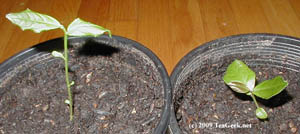In a post from February, I noted that I’d become a proud father of two tea plants. At that time I promised an update sometime in the future. Well, now that the li’l tykes are 6 months old (and because there’s been some talk on Twitter and various tea-related forums about tea propagation), it’s time for that update!
As a reminder, here’s what they looked like in February 2009:

I’ve decided to call them Laurel and Hardy…for the obvious reasons. And these guys are a great example of two things in the tea industry.
First, they show why so many cultivated tea plants are taken from cuttings rather than seed. Since good old L&H here were both from seeds of the same plant, you’d think they’d be more similar. However, Camellia sinensis is one of those plants that has a lot of variation when there is sexual reproduction, and one that can’t effectively self-pollinate. Now, I don’t know who the father is (or “fathers are”). I’ve got another tea plant but I don’t think it bloomed that year; I’ve got a Camellia japonica in the front yard, but I’m not sure if cross-species pollination can occur within the genus Camellia. If it works like horses and donkeys, my two kids could be mules…and possibly sterile. But I’m not yet clear on how the genetics works with the tea plant.
With two clearly different plants coming from seed of the same mother plant, you can see why tea farmers would want to plant cuttings rather than seeds if they find a plant that does what they want. If the farmer plants seeds, who knows what they’ll get? But if they plant cuttings, they’re making a clone of the parent bush…ensuring a consistent and predictable crop.
The other thing this illustrates is how new cultivars come about. While cuttings result in the predictability of clones, sexual reproduction produces lots of variation—like Laurel and Hardy. If one of the freaky, doesn’t-look-like-Mom kids has some new quality that benefits the farmer—like producing a sweeter-tasting tea, or resisting pesky bugs, or more easily surviving bad weather—then the kid may get cloned, or selectively cross-pollinated with other plants. Eventually, when the genetics settle down, you’ve got a new cultivar (short for “cultivated variety”).
For now, I’ll just let ’em have their childhood until they grow up and get to work producing leaves for me. But maybe I’ll be able to develop my own Tea Geek cultivar in the next 10 years or so.

 SM: Currently, and this is subject to change, is the white tea I have been producing. A close second would be Onomea Tea’s orthodox black tea. (And yet I need to reserve a spot for an oolong too, but which one? and if I had to include a green it would be a gyokuro, which we learned how to make from a Japanese master.)
SM: Currently, and this is subject to change, is the white tea I have been producing. A close second would be Onomea Tea’s orthodox black tea. (And yet I need to reserve a spot for an oolong too, but which one? and if I had to include a green it would be a gyokuro, which we learned how to make from a Japanese master.)